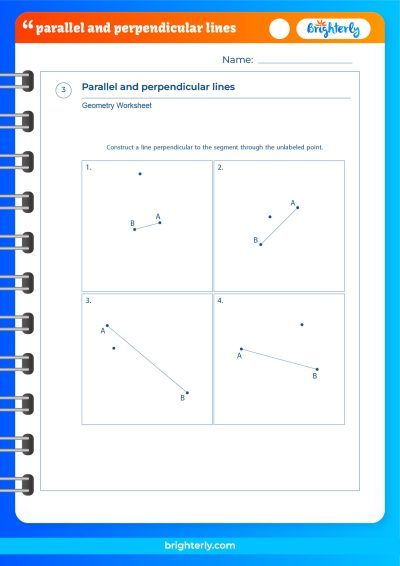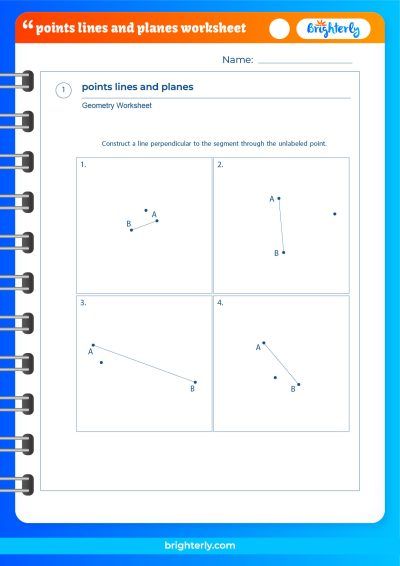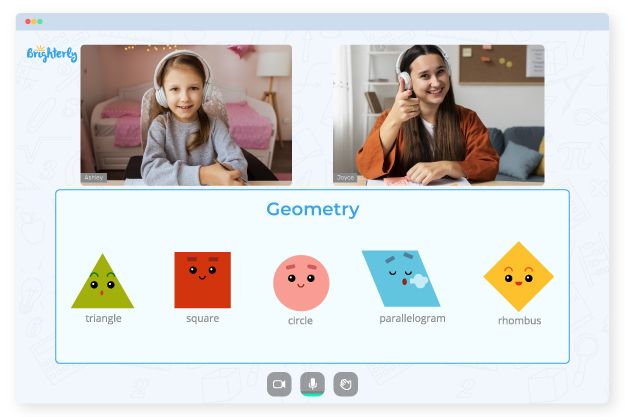Line – Definition, Types, Facts, Examples
Updated on January 1, 2024
At Brighterly, we believe in making complex mathematical concepts easy and enjoyable for children to learn. Lines are the building blocks of geometry, and understanding them is crucial for young learners to excel in mathematics. In this blog post, we will delve into the exciting world of lines, exploring their different types, properties, and how they relate to other geometric shapes. We’ll also provide engaging examples and practice problems to help children grasp these concepts effortlessly. So, let’s embark on this fascinating journey of lines together and help your child unlock their full potential in mathematics!
Lines are the foundation of geometry and essential for children to grasp as they pave the way for understanding more intricate shapes and figures. In this comprehensive guide, we will uncover the diverse types of lines, examine their properties, and offer valuable examples and practice problems designed specifically for young learners. At Brighterly, we are committed to helping your child develop a deep understanding of mathematical concepts, and lines are no exception. So let’s dive in and explore the fascinating world of lines together!
What is a Line?
A line is an essential concept in mathematics, representing an infinitely long, straight, one-dimensional path that extends without end in both directions. With no endpoints, lines are often denoted by a lowercase letter, such as ‘l’, or by two points on the line, like ‘AB’. At Brighterly, we encourage learners to explore the world of lines and their properties through valuable resources like Brighterly. By understanding the fundamentals of lines, children will be better equipped to tackle more complex geometric concepts in the future.
To expand your comprehension of the concept of Lines, we recommend exploring the math worksheets offered by Brighterly. These materials are created to assist you in learning and consolidating your understanding of this topic in mathematics.
What is a Line Segment?
A line segment is a portion of a line that has two distinct endpoints, representing a finite section of a line with a measurable length. Often depicted by a line with two capital letters indicating the endpoints (e.g., ‘AB’), line segments can be thought of as “snippets” of lines that have been cut at both ends. To further explore line segments and enhance your child’s understanding, we recommend visiting informative websites such as Brighterly. With a solid grasp of line segments, young learners will be better prepared for more advanced geometric topics.
What is a Ray?
A ray shares similarities with a line segment; however, it possesses only one endpoint and extends indefinitely in a single direction. Rays are typically represented by a lowercase letter followed by an arrow (e.g., ‘r →’) or by an endpoint and another point on the ray (‘AB →’). Rays can be viewed as a hybrid between lines and line segments, having a starting point but continuing infinitely in one direction. To learn more about rays and their unique properties, we suggest exploring resources like Brighterly.
Types of Lines
Geometry encompasses various types of lines, often categorized by their relationships with other lines. Common types include parallel lines, perpendicular lines, horizontal lines, and vertical lines. Let’s examine each of these types more closely.
What Are Parallel Lines?
Parallel lines are lines that never intersect or touch, maintaining a constant distance apart and possessing equal slopes. In a coordinate plane, two lines are parallel if their equations share the same slope but have different y-intercepts. To enhance your child’s understanding of parallel lines, we recommend resources like Brighterly. Familiarity with parallel lines is crucial for grasping more advanced geometric concepts.
Horizontal And Vertical Lines
Horizontal lines are lines that run parallel to the x-axis in a coordinate plane. They have a slope of 0 and are represented by equations in the form y = k, where k is a constant. Vertical lines are lines that run parallel to the y-axis in a coordinate plane. They have an undefined slope and are represented by equations in the form x = k, where k is a constant.
Solved Examples on Lines
Let’s explore some solved examples to better understand the concepts of lines, line segments, and rays:
-
Example 1: If line segment
ABhas a length of 8 units and line segmentBChas a length of 6 units, what is the length of line segmentAC?Solution: Since line segments
ABandBCare consecutive, we can add their lengths to find the length of line segmentAC:AC = AB + BC = 8 + 6 = 14units. -
Example 2: Are the lines
y = 2x + 3andy = 2x - 5parallel, perpendicular, or neither?Solution: Since both lines have the same slope (2), they are parallel.
-
Example 3: Find the equation of a line perpendicular to the line
y = -3x + 1and passing through the point (2, 4).Solution: Since the slope of the given line is -3, the slope of a line perpendicular to it is 1/3. Using the point-slope form, we can write the equation of the perpendicular line as
y - 4 = 1/3(x - 2). Simplifying the equation, we gety = 1/3x + 10/3.
Practice Problems on Lines
Here are some practice problems to help children reinforce their understanding of lines:
- Find the length of the line segment with endpoints A(-2, 1) and B(4, 5).
- Determine whether the lines
y = -4x + 6andy = 1/4x - 2are parallel, perpendicular, or neither. - Find the equation of a line parallel to the line
y = 3x - 7and passing through the point (1, -2).
Conclusion
Mastering the concept of lines and their properties is paramount for establishing a robust foundation in geometry. This comprehensive Brighterly blog post has covered everything from line segments and rays to parallel, perpendicular, horizontal, and vertical lines, providing your child with the essential knowledge they need. Through consistent practice and determination, young learners will become more confident in their ability to recognize and work with lines in various mathematical situations.
At Brighterly, we strive to create engaging, informative, and unique content to support your child’s learning journey. We understand the importance of nurturing a strong foundation in mathematics, and our aim is to make these complex concepts enjoyable and accessible for children. With our expert guidance and your child’s dedication, they will be well on their way to becoming a math whiz in no time!
Frequently Asked Questions on Lines
Why are lines important in mathematics and geometry?
Lines are essential because they form the basis for many geometric shapes and figures. Understanding lines and their properties helps students develop a strong foundation in geometry, which is crucial for studying more complex shapes and concepts.
How can I remember the difference between a line, a line segment, and a ray?
A line extends indefinitely in both directions, a line segment has two endpoints, and a ray has one endpoint and extends indefinitely in one direction. Remembering the characteristics of each can help you differentiate between them more easily.
How are slopes of parallel and perpendicular lines related?
Parallel lines have the same slope, while the slopes of perpendicular lines are negative reciprocals of each other. In other words, if the slope of one line is ‘m’, the slope of a line perpendicular to it is -1/m.
Can a horizontal line be perpendicular to a vertical line?
Yes, a horizontal line is always perpendicular to a vertical line. Horizontal lines have a slope of 0, while vertical lines have an undefined slope, so their slopes are negative reciprocals of each other, satisfying the condition for perpendicularity.
How can I find the length of a line segment if I know the coordinates of its endpoints?
To find the length of a line segment with endpoints A(x1, y1) and B(x2, y2), you can use the distance formula: AB = sqrt((x2 - x1)^2 + (y2 - y1)^2).
Information Sources
Some sources used in this article include:






